AdWords Sitelinks: How to hack this ad extension to get more conversions?
Google search is a serious business with a lot of money in circulation. And money does not come by accident.
Google motivates the users to click on the ad instead onto the organic result listing.
Google motivates advertisers to create ads that incentive clicks.
Whether you would like to admit or not, still users are clicking on the AdWords ads. You, guys that invest money in PPC get traffic. That is an excellent news for you because that gives you competitive advantage (clicks are going your way, not to competitors), you get visits that convert into buyers of your products or services. Google’s budget increases. As I already wrote, money does not come by accident.
Time of the simple ads has passed long time ago. Headline, description and link are obsolete. Today ads have a bunch of extensions.
-Sitelinks (the additional clickable links)
- Callouts (additional 25-character long punchlines)
- Pricing extensions (Listing of priced products)
- Call extensions (a click-to-call phone number)
Of course, there are many more.
Simply said, ad extensions help you to stand out in the crowd and to dominate search results page. You get a substantial real estate that suppresses other competitors out of the viewport.
One set of ad extensions is passive. They are presented as a text, additional line or punchline etc. User is not able to perform any action against them but to read them (i.e. Callouts).
Problem occurs when we are working with active extension, those that are interactive. Click on a sitelink, calling a phone number, looking into the map directions (location extensions). Wrong phone number, and we are in trouble. Wrong address and one more problem. Clicking on the irrelevant sitelink and yes, we have a problem.
Elephant in the room
Let’s take for an example a sitelink (an additional link). Sitelink is the great way to attract clicks, but also, they are “a fantastic” way to waste money.
I am searching for something, I click on the sitelink, and I drift away to a page that has nothing to do with the thing I have just searched on Google.
Please take a look at the following example.
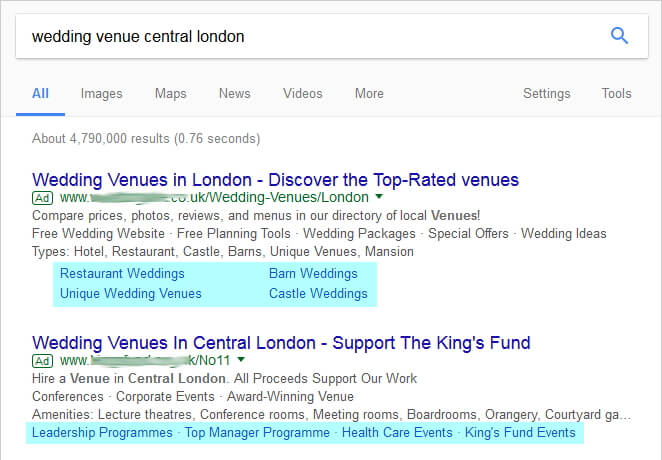
An example of the sitelink extension
You can see by yourself all those marked links. Castles, farms, events (in the health industry, in the management…). A customer looking for a wedding venue in the center of the London expects to get… well comparison of restaurants, hotels and other wedding venues.
In most cases advertisers simply put some irrelevant links in the sitelinks. They are just trying to fill-in something. Something that will take-up space and push competitors down.
What does data from the web analytics say?
How often are these links being clicked? “C’mon, no way that they get significant traffic, in 99% of cases user simple click on the headline.
Here is the report:
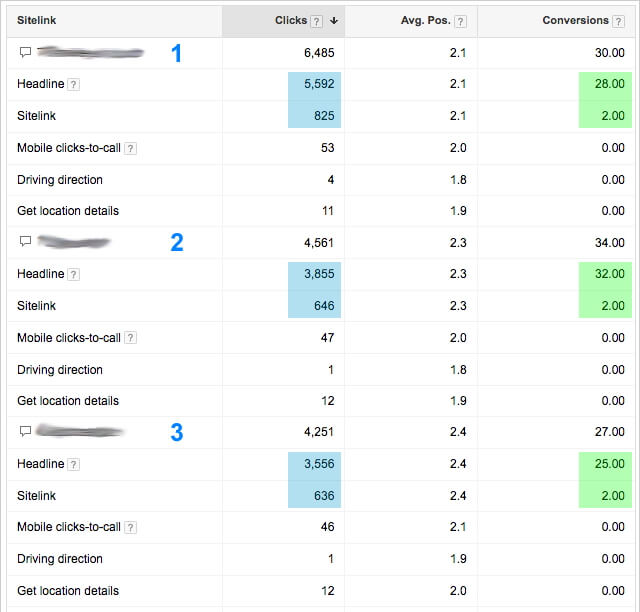
Performance report for sitelinks (and other) add extensions from the AdWords
I marked important zones, so you can easily follow the report.
- This is the report for three sitelink extensions, 1, 2 3- Blue color marks clicks
- Green color marks conversions.
Sitelink 1
When being displayed Sitelink 1 gets 825 clicks, and the ad headline 55892. This means that the Sitelink 1 gets 12.7% of clicks (blue).
Sitelink 1 brought two conversions, and the headline 28. Sitelink 1 is responsible for 6.6% of conversions (green).
Sitelink 2
Sitelink 2 takes 16.7% of clicks.
Sitelink 2 brings 6.2% of conversions.
Sitelink 3
Sitelink 3 takes 14.9% of clicks.
SSitelink 3 brings 8% of conversion.
“Wait a minute Nenad, this is not great! Ideally users should land on the page that is extremely relevant to the query they typed into the Google search box. That will ensure I won’t get that drop in conversions for all the clicks that go to the sitelink.”
So, the solution for sitelink is dead simple.
Create such a set of sitelink so all links have the same content. Just change the headline and the description of a sitelink.
For an example: LED TVs, LED TV Deals, Full HD LED TVs. And then link all of them to the same page with the bunch of LED TVs.
Well, that is not possible.
Google is smart and does not want people to manipulate the system. AdWords has a policy that states: content on the landing page and on the sitelink page can match only by 20%. Simply put: you need to have 80% of unique content.
OK, back to the drawing board. First, I investigated how big companies approached this problem. The best solution I found on Booking.
Please take a look at the examples below and learn how they deal with the sitelinks dilemma.
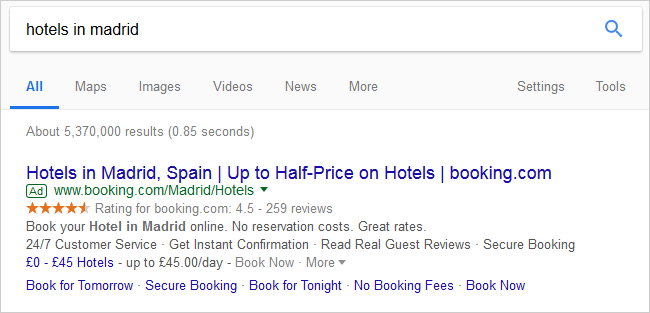
Search results with the Booking's ad
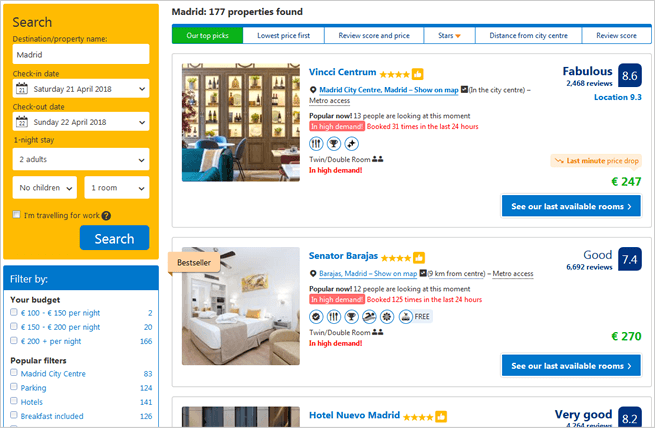
Currently available hotels (see how the date has already pre-filled)
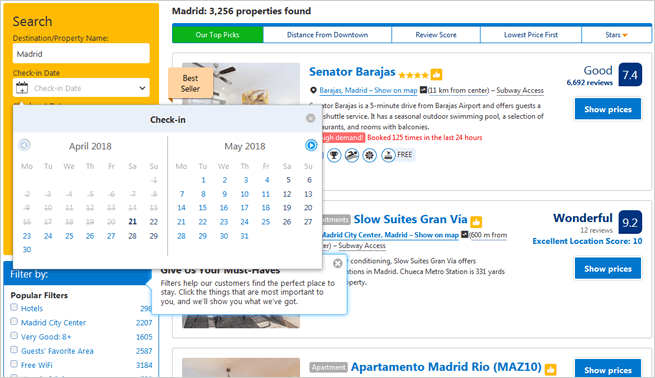
All Madrid hotels (the system gives me the option to input a date)
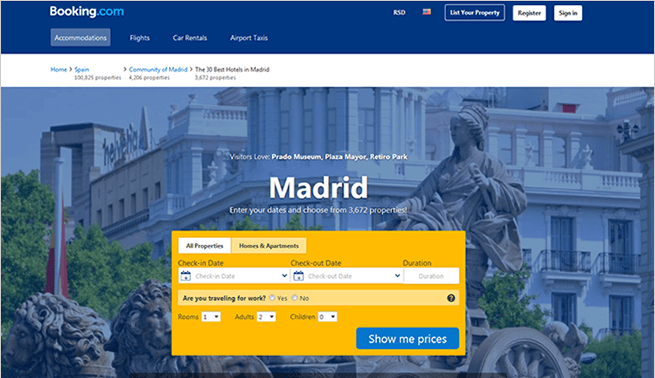
The third sitelink is a search page with a predefined location for Madrid
Perfect. Two or three sitelinks are showcasing category pages Madrid, but search result pages contain different hotels. This solved the problem of the unique content. Of course, site visitors get what they were searching for, therefore user experience is not compromised.
Furthermore, one of the sitelinks takes users to the search results. Not some generic one, but the search for Madrid hotels.
Customer, googling hotels in Madrid gets the perfect experience no matter which sitelink they click on. Landing on any pages puts them into the process of comparing accommodation options. I believe that Booking has sitelink conversion rate mush better than those 7-8%.
How to implement this method on your website?
If you have a website in travel industry or an ecommerce website then implement Booking’s method: create couple of sitelink pages with different products/services and one search results page. Criteria that you can use to modify products can be price (low to high, high to low…), name, type of the product, services by location etc. Be creative.
Important advice. Make sure that you match the main heading (H1) on the page with the search query that visitor typed on Google. If they were searching for “Winter coats” then your main heading on the page should have prominent “Winter coats” title.
For this to work you should have nicely organized Adwords account that contains many granulated Ad Groups with low number of highly relevant keywords.
Take a look at SKAG methodology for structuring an account.
At the first glance the whole process might look complicated, but actually creating variations of sitelink pages is not a huge task. Every decent CMS can easily produce unique URL for any combination of products on the page.
These pages do not need to be internally linked on your live website. You do not need to link to them via main navigation. Feel free to put noindex tag onto them. You are not creating duplicated content here; you are simply providing user with the best possible landing page for their query. Visitors will not bounce, but convert in the higher rate.
If you have 10 products and you want to showcase 7 on the page then you can create 120 fully unique combinations of pages. You remember that from math (n=10, k=7).
Creating search results pages is a bit more complex, but can be solved with using few URL parameters. You developers can easily provide you with few URLs.
Why should you worry about the sitelinks?
Because the results are excellent. You will have higher conversion rate, you will lower cost per conversion, and finally you will improve ROI of PPC advertising. Lowering the negative effect of critical elements in the AdWords is important part of the PPC hygiene.
No segment should be neglected. In AdWords there are always bunch of elements to analyze, fix and optimize. Let’s start with sitelinks ad extensions.